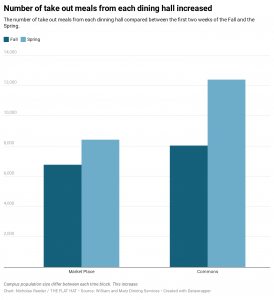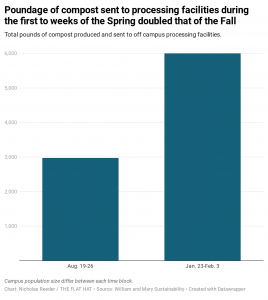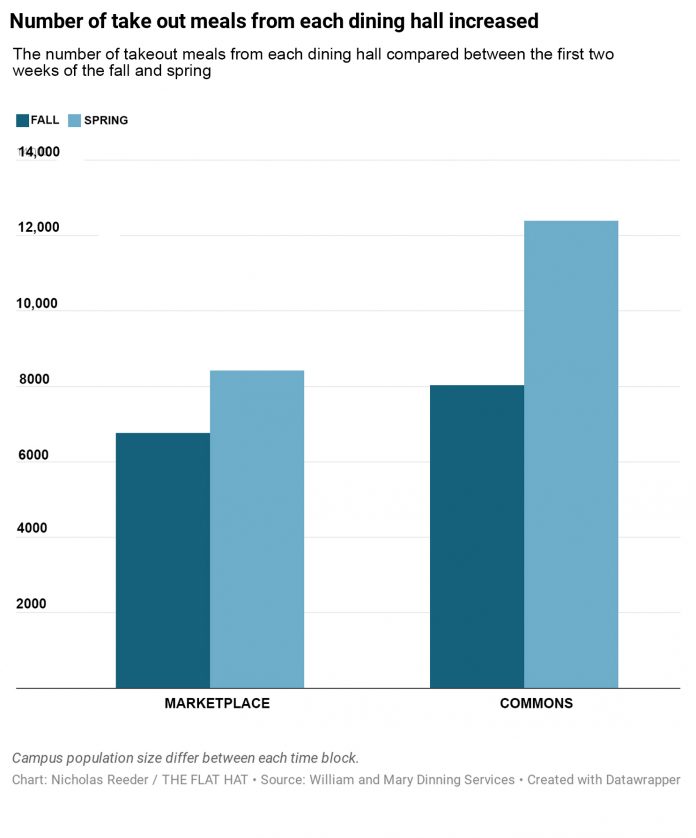Upon their phased return to campus, students at the College of William and Mary were greeted by a change in policy for the new semester: takeout–only dining. Statewide COVID-19 restrictions led the College to suspend indoor seating in dining halls until Feb. 10, coinciding with the start of in-person classes.
The Flat Hat examined the environmental impacts of takeout-only meal options, and how the College struck a balance between keeping the community safe and minimizing adverse effects of increased waste. According to data from the College’s Dining Services and W&M Sustainability, there was more waste produced from plastic cutlery, to-go boxes and other essentials for takeout food during the opening weeks of the spring semester than in the first two weeks of the fall semester.
Comparing the first two weeks of the fall and spring semesters, there has been a 40% total increase in takeout meals served across the College’s dining halls. In the first two weeks of the fall semester, 55% of meals across the College’s dining facilities were takeout, compared with the 100% mandated by the College during the phased move–in for the spring semester. At Marketplace, the percentage of takeout increased by 19.6% of meals from last semester; however, meals at Marketplace are always packaged for takeout. One possible reason for this growth is that two different sets of students moved in during the fall and spring semesters. Resident District Manager of Dining Services Jason Aupied said that because different groups and social classes of students were allowed back on campus within those time frames, it is difficult to make a direct comparison.
of the fall semester, 55% of meals across the College’s dining facilities were takeout, compared with the 100% mandated by the College during the phased move–in for the spring semester. At Marketplace, the percentage of takeout increased by 19.6% of meals from last semester; however, meals at Marketplace are always packaged for takeout. One possible reason for this growth is that two different sets of students moved in during the fall and spring semesters. Resident District Manager of Dining Services Jason Aupied said that because different groups and social classes of students were allowed back on campus within those time frames, it is difficult to make a direct comparison.
“You won’t quite have an apples-to-apples comparison, because in the fall, the university brought back half of the on-campus students for the first two weeks; then the other half of the students returned,” Aupied said. “In the spring, we saw new students, student athletes and freshmen return to campus, with seniors returning a week later than the rest of the on–campus student body returning this weekend.”
The College has taken some steps to mitigate this increase in waste by purchasing
compostable flatware , to–go containers and straws, as well as increasing the number of receptacles for these items. Dining fellow Samuel Laveson ’20 said there has also been an increase in compost bin usage. In the first two weeks of this semester, there have been almost 3,000 more pounds of waste in the College’s compost bins than in the first two weeks of the fall semester. Laveson also said that he’s seen an increase in composting at Commons Dining Hall, Marketplace and outside of Green and Gold Village.
, to–go containers and straws, as well as increasing the number of receptacles for these items. Dining fellow Samuel Laveson ’20 said there has also been an increase in compost bin usage. In the first two weeks of this semester, there have been almost 3,000 more pounds of waste in the College’s compost bins than in the first two weeks of the fall semester. Laveson also said that he’s seen an increase in composting at Commons Dining Hall, Marketplace and outside of Green and Gold Village.
Director of Sustainability, Calandra Waters Lake, has also noted the increase in waste and composting.
“In response to the increased takeout, the outdoor bins for compost collection have gone from two bins to eight and counting,” Waters Lake said. “This waste is transported to a facility in Waverly, Virginia, where it is composted at an industrial scale. Some of that compost is used on campus and at KelRae Farm, whom W&M partners with on growing food for the dining halls, along with educational and team building activities.”
“In response to the increased takeout, the outdoor bins for compost collection have gone from two bins to eight and counting,” Waters Lake said. “This waste is transported to a facility in Waverly, Virginia, where it is composted at an industrial scale. Some of that compost is used on campus and at KelRae Farm, whom W&M partners with on growing food for the dining halls, along with educational and team-building activities.”
With the takeout-only policy, dining hall employees were no longer required to clean the tables after each use. Some employees, like Commons Dining Hall employee Stanley Charity, felt that the takeout-only policy was beneficial.
“For everyone’s purposes, I feel it was a good thing,” Charity said.

